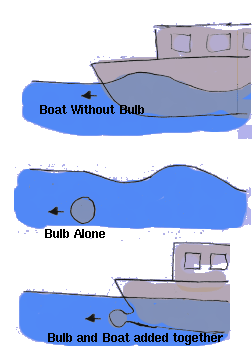
| |
Have you ever thrown a stone into a pond and watched the waves going out in a circle? This experiment gets really interesting if you throw two stones at once. In some places the high parts of the two waves will meet creating an even higher spot. In other places the lower parts of the two waves will meet making an even lower part. And in other places a high part of one of the waves will meet the low part of the other wave, creating a perfectly flat place.
All these effects can be studied by adding two sine waves together. Take a look
at the magic picture below which shows three waves; two which you can directly
control and a third one which is the result of the upper two added together.
Can you find two waves wich cancel each other out when added together, so that only a straight line is left at the bottom? Try to find different ways to do that!
In boat construction you can find a use of adding waves together which cancel each other out. Have you ever seen an older ship creating great big waves? For swimming, these waves are nice but do you think the boat company likes them? No way! Because the boat is wasting part of its fuel creating big waves.

There is an interesting way to reduce the waves a boat creates by attaching a bulb to the front of the hull. If you take a look at a normal boat, you will see that it creates a wave which starts going up from the place where the hull meets the water.
But how does the bulb work? If you pull a ball at some speed over a surface of water, the ball will start to pull itself into the water. (You can try this with a balloon in your bathtub.) The water has to move around the ball and it accelerates. Fluids in motion have a lower pressure, in this case the pressure is small enough that it can pull the ball down into the water. Exactly the same thing happens with the bulb which modern ships have attached to their hull. The water around the bulb has a lower pressure so it pulls the surounding water to itself. This pull creates a wave on the surface of the water which first goes down and then up. This wave cancels out the wave created by the hull, allowing the boat to float through water leaving hardly any waves.
